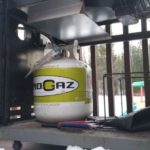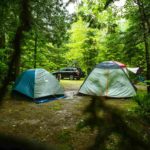A good camping sink with running water can add some major convenience to your camping kitchen. Going minimalist is fun, but let’s face it, sometimes when we’re out camping it’s still really nice to have a few of the luxuries of home.
Having running water and a sink makes washing dishes and preparing meals so much easier and more enjoyable. Not to mention washing hands and keeping kids and pets semi-clean while living in the great outdoors for a few days or more.
What to look for in a camping sink and table
The ideal camping sink would come with a sturdy base and some counter space. The best ones are portable, durable and functional for all of your intended uses. Surprisingly, the options are quite limited when it comes to camping sink and table combos, but there are a few that stand out with some really cool features that make it easy for washing hands and preparing meals.
There are a few valuable questions you should ask yourself when considering which camping sink and table is best for you.
A portable camping sink:
The first will relate to the size and portability of the unit. Having a nice big sink and table is great, but it needs to be transportable at the same time. A unit with foldable legs makes it easy to reduce the size so it can be stored away while traveling.
Ease of setup:
How easy is it to put together at the campsite? You do not want to spend hours setting up your kitchen. A good foldable camp sink and table should be able to unfold in minutes if not seconds. There may be a little setup for water connections and storage units, but again this shouldn’t take long.
Durability for years of use:
What material are the parts made of? Most often the majority of the parts are made from plastic or aluminum. This is perfectly fine for the sink and countertop. However, the table legs and brackets should be made of a strong material like steel to avoid buckling. Whatever material you choose, make sure it suits you and your families wear and tear history.
Design features:
Does it come with all of the bells and whistles you’d like such as hooks for hanging utensils and shelves for storage of kitchen and cleaning items?
Camping Sink with Running Water
Having running water is clearly an added bonus to your camp kitchen that will make life much easier around the campsite. However, adding in this functionality brings about some extra questions.
How much water do you need for camping?
Typically, you can expect to use about 2 gallons or 7.5 liters of water per day per person. This should accommodate your drinking water needs as well as cleaning and hygiene uses. Therefore, a family of four will use approximately eight to ten gallons of water each day.
How big is the water tank?
The water tank does not have to match your daily usage. However, you do need to consider how many times a day you are willing to fill the tank. Most people probably don’t mind filling it one or two times per day depending on how far away your fill station is. Anything more than that will likely get tiresome in a hurry.
What type of water pump is used?
There are two main types of pumps that can be used for running water at your camp. A foot pump or a small electric battery powered pump.
A foot pump operates by repeatedly stepping on a pedal, which forces the water up through the faucet.
An electric or battery operated pump operates similar to a well pump, just on a smaller scale. Turning the faucet on engages the pump, forcing water to flow. An electric pump is more convenient, although it will come with a higher price tag.
The Best Camping Sinks with Running Water
SereneLife Portable Camping Sink with Running Water
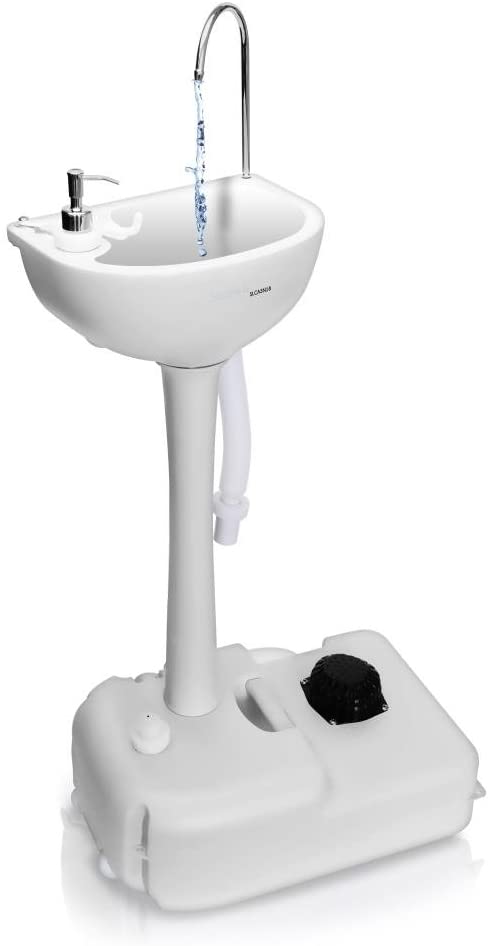
The SereneLife Portable Camping Sink is a lightweight option made of high density polyethylene (plastic). It comes equipped with a 5 gallon (19 liter) water tank capacity and is operated by a foot pump. This is a great option as a hand washing unit as it also provides a soap dispenser and towel rack.
Due to its size and lack of any counter space, it is difficult to use this as a camp kitchen unit. Albeit, you could place a table beside it and get the same basic functionality.
With a 40 inch faucet height, this camping sink sits high enough to accommodate most adults comfortably, while also being low enough that kids can reach as well.
| The Highlights | Room For Improvement |
| Lightweight: 10.4 lbs or 4.7 kilograms | No drain bucket included |
| Low enough for kids to use | Shape of sink – splash prone |
| Safe materials for handwashing, food washing and drinking | Wheels are small and plastic, not great on sand |
| Quick Assembly | Plastic threaded connections – prone to wear and tear |
Outsunny Portable Camping Sink with Recovery Tank
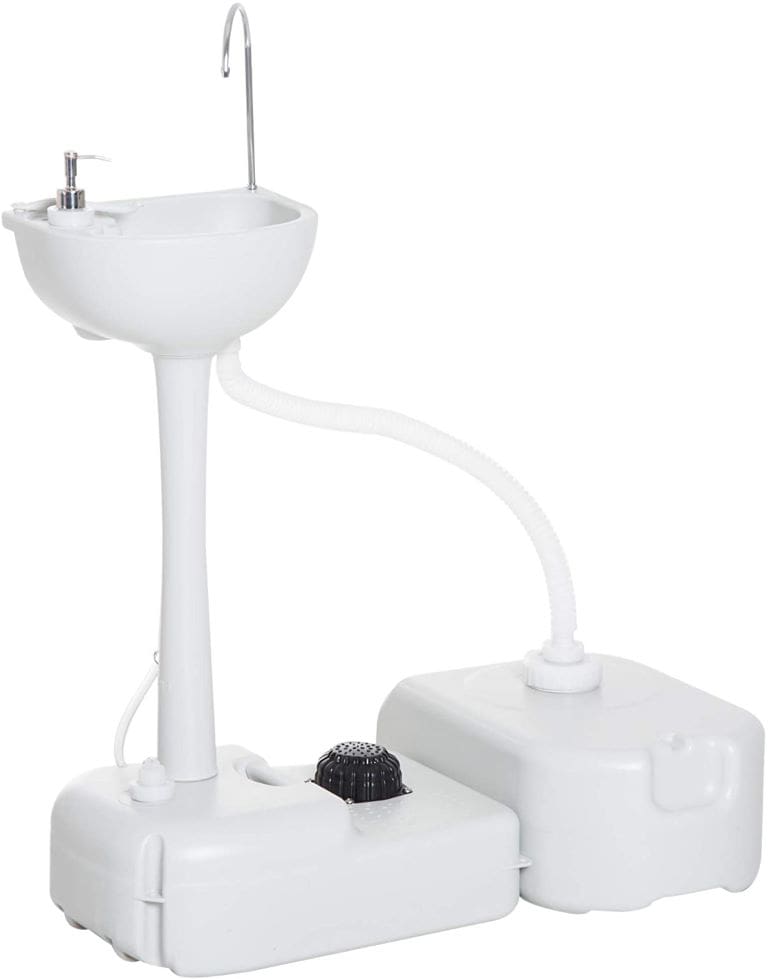
The Outsunny Portable Camping Sink is similar to the SereneLife, with one noticeable difference. This one comes with a 6.3 gallon (24 liter) recovery tank for greywater. This model is still operated by a foot pump and has a water tank size of 4.5 gallons (17 liters). That is slightly smaller than the previous tank size of 5 gallons (19 liters).
The recovery tank adds a little extra weight and size to the unit, although it is completely detachable and can be carried and stored separately. One thing to keep in mind with this or any recovery tank is the weight that it will be when filled. Each liter of water weighs approximately one kilogram (2.2 pounds). The weight of this tank when filled would be around 55 pounds. There is a nice carrying handle on the tank, however that is quite a lot of weight to carry over a distance.
| The Highlights | Room For Improvement |
| Recovery tank for greywater | Shape of sink – splash prone |
| Low enough for kids to use | Wheels are small and plastic, not great on sand |
| Safe materials for handwashing, food washing and drinking | Awkward to move when recovery tank is connected |
| Quick Assembly | Plastic threaded connections – prone to wear and tear |
SereneLife Portable Camping Sink with 30L Capacity
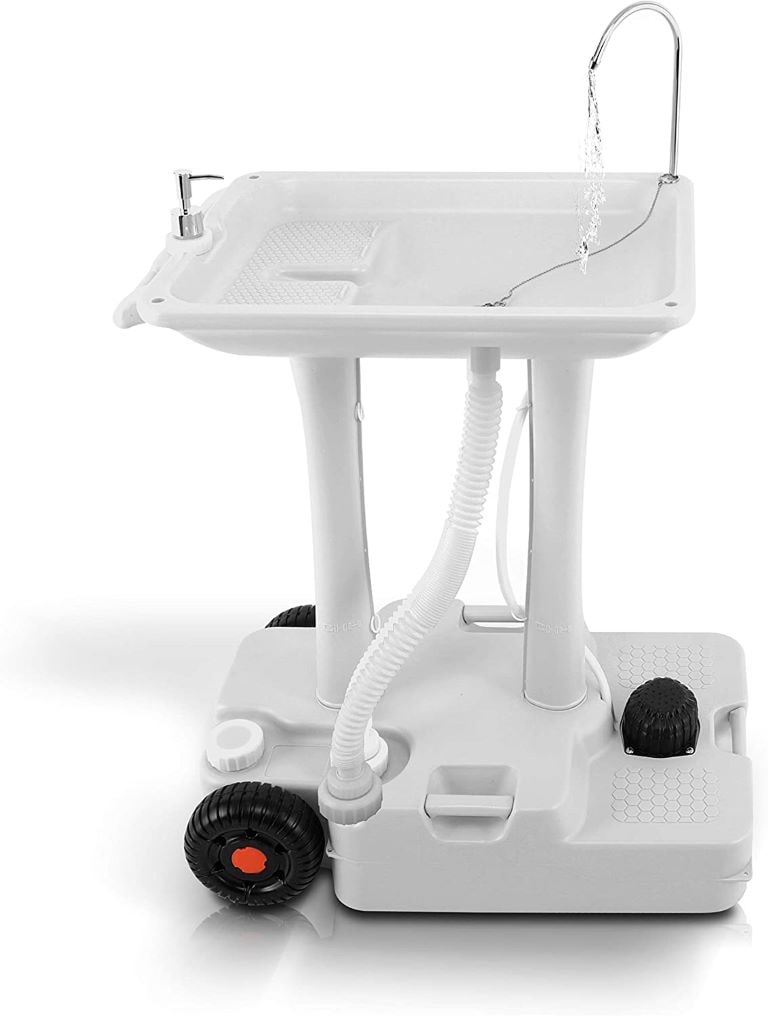
The SereneLife Jumbo Portable Camping Sink is an upgrade to the other models we’ve talked about. For one, the shape and size of the sink is more practical for uses beyond washing hands. It’s flatter design makes it functional for washing dishes as well.
The water tank size is an upgrade as well, with an 8 gallon or 30 liter capacity. While the added water capacity does add weight to the unit, it’s not such a problem with this model. That’s because this portable sink comes with extra large wheels and a convenient pull handle that make moving it around the campsite easy. In addition, the foot pump on this model provides a bigger flow than the other models.
| The Highlights | Room For Improvement |
| Convenient sink shape – no splashing | No recovery tank included |
| Large water tank | More expensive than other models |
| Large wheels make it easy to move | 18 pounds – heavier than other models |
| Quick Assembly |
Cabela’s Deluxe Fillet Table
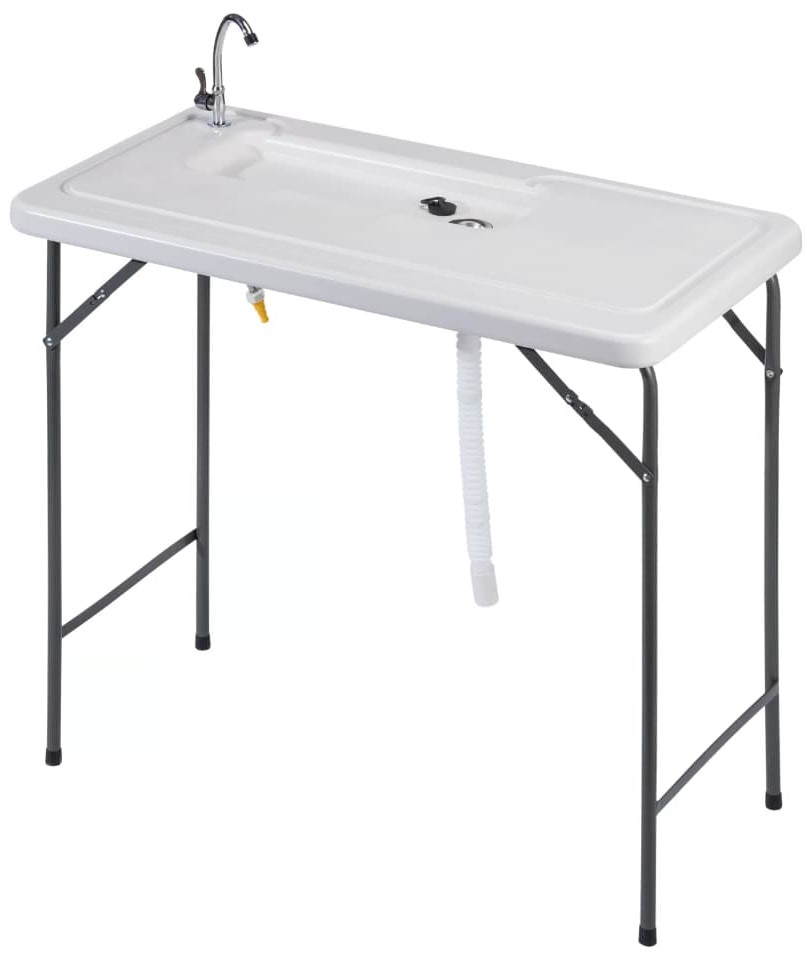
The Deluxe Fillet Table from Cabelas has been designed as a fish cleaning unit for the backyard. Nevertheless, it is a suitable option for a camp kitchen site as well. It is both sturdy and heavy duty, with a weight capacity of 150 pounds.
It’s got ample counter space to prepare meals on an easy to clean polyethylene surface that is safe for foods.
Where this unit falls short is in the sink size and depth, It is quite shallow which makes soaking dishes in it nearly impossible. However, it works perfectly fine for handwashing and rinsing food.
For water supply, the faucet can be connected to an outside tap via a garden hose. Clearly this wouldn’t be possible at a campsite, and as such you would need to purchase a water supply tank and a small electric or foot pump to feed the faucet.
| The Highlights | Room For Improvement |
| Good counter space | No recovery tank included |
| Easy to clean surface | No water supply tank included |
| Heavy Duty | No pump included |
| Folds flat for easy transport | Would require a DIY water tank and pump setup |
Small, Portable Camping Sinks and Camping Wash Basins
You might find that full size camping sinks with running water are just too big to transport around or that you simply don’t need such an elaborate setup. In those cases, it’s still a good idea to have some form of small, portable camping sink to wash your hands and maybe a few dishes.
I really like the collapsible camping wash basins for this because they are easy to store for transport and they come in various shapes and sizes.
Collapsible camping equipment has really taken the industry by storm over the last few years with everything from bowls to pots to, you guessed it…sinks, being available. It’s no wonder though! The versatility of these items is everything campers and backpackers look for.
DIY Camping Sink
If you’ve got the creativity and tools then you can most definitely build your own camp kitchen and make it as elaborate as you want. This gives you the ability to make it completely unique from others and equip it with running water, your choice of water pump, and as much utensil hanging and storage area as you like.
There are some really neat designs made from a wide array of materials like PVC pipe, wood, plastic shelf units. Here’s one made from a resin rack shelf unit that I think is really cool! It is easy to make and could be constructed for under 75 bucks.
Disposing of greywater while camping
Whether you have a self-contained unit or not, you will have some amount of greywater which needs to be disposed of. In general, it is legal and permissible to dispose of greywater on the ground when it has been used for washing dishes and hands.
If doing so, it is always best to use biodegradable soaps that won’t leach into water and potentially harm local ecosystems. Be environmentally conscious of the products you bring into the wilderness.
If you’re staying at a campsite, then there may be a dedicated location to dispose of greywater. Be sure to check when you arrive.
How to fix a broken foot pump on a camping sink
Foot pumps are made of plastic and rubber. Overtime, repeated use will wear down the components. If your sink is left out in the sun a lot it may also cause some weather cracking.
If a foot pump stops operating, it is likely due to a crack in some piece of equipment. The result is air entering the pump which therefore won’t allow water to pump through.
In order to repair a broken foot pump, first inspect the rubber for any cracks. If nothing is noticeable on the rubber, remove the pump from the water tank and check the hoses and plastic connections for cracks. You may be able to replace a piece of a foot pump or you may need to replace the whole pump.
A new camping sink foot pump can cost between $20 and $40.

How to unclog a soap dispenser
Soap dispensers often become clogged because of infrequent use. The left over soap inside the hoses can dry up, causing stubborn clogs. Unclogging a soap dispenser can be accomplished in a few step.
- First, remove the soap dispenser by unscrewing it from the base.
- Next, remove as much built up soap from the tube as possible by using a screw drive, pipe cleaner or anything else that can reach as far down the hose as possible.
- Soak the pump in a bowl of hot water. This will loosen up any remaining soap clogs.
- Lastly, reassemble and test the pump. If there still seems to be a clog, retry all steps until the dispenser is working properly.
We love writing about the things that make a real difference in your outdoor experience. Some of the links in this post are affiliate links in which case we may earn a small commission at no extra cost to you if you make a purchase. We truly appreciate you taking the time to read our content and hope it has added value to your next camping and outdoor adventure.

